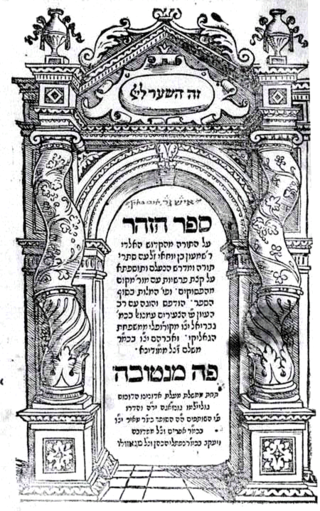
The Zohar is a foundational work of Kabbalistic literature. It is a group of books including commentary on the mystical aspects of the Torah and scriptural interpretations as well as material on mysticism, mythical cosmogony, and mystical psychology. The Zohar contains discussions of the nature of God, the origin and structure of the universe, the nature of souls, redemption, the relationship of Ego to Darkness and "true self" to "The Light of God".
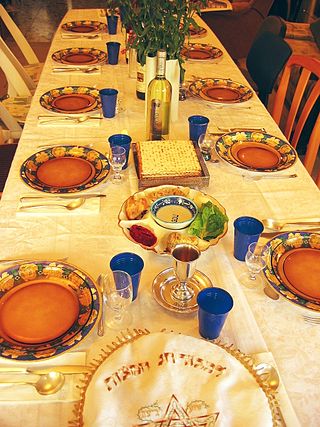
The Passover Seder is a ritual feast at the beginning of the Jewish holiday of Passover. It is conducted throughout the world on the eve of the 15th day of Nisan in the Hebrew calendar. The day falls in late March or in April of the Gregorian calendar. Passover lasts for seven days in Israel and, among most customs, eight days in the Jewish diaspora. Where seven days of Passover are observed, a seder is held on the first night; where eight days are observed, seders are often held on the first two nights, the 15th and 16th of Nisan. The Seder is a ritual involving a retelling of the story of the liberation of the Israelites from slavery in ancient Egypt, taken from the Book of Exodus in the Torah. The Seder itself is based on the Biblical verse commanding Jews to retell the story of the Exodus from Egypt: "You shall tell your child on that day, saying, 'It is because of what the LORD did for me when I came out of Egypt.'" At the seder, Jews read the text of the Haggadah, an ancient Tannaitic work. The Haggadah contains the narrative of the Israelite exodus from Egypt, special blessings and rituals, Talmudic commentaries, and Passover songs.
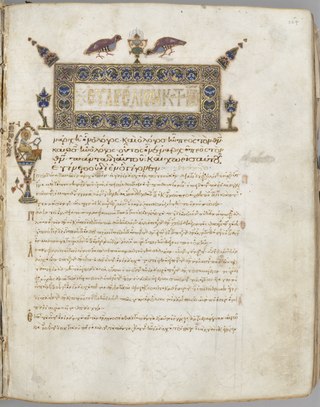
An illuminated manuscript is a formally prepared document where the text is decorated with flourishes such as borders and miniature illustrations. Often used in the Roman Catholic Church for prayers and liturgical books such as psalters and courtly literature, the practice continued into secular texts from the 13th century onward and typically include proclamations, enrolled bills, laws, charters, inventories, and deeds.

The Haggadah is a Jewish text that sets forth the order of the Passover Seder. According to Jewish practice, reading the Haggadah at the Seder table is a fulfillment of the mitzvah to each Jew to tell their children the story from the Book of Exodus about God bringing the Israelites out of slavery in Egypt, with a strong hand and an outstretched arm.

The Sarajevo Haggadah is an illuminated manuscript that contains the illustrated traditional text of the Passover Haggadah which accompanies the Passover Seder. It belongs to a group of Spanish-Provençal Sephardic Haggadahs, originating "somewhere in northern Spain", most likely city of Barcelona, around 1350, and is one of the oldest of its kind in the world.

Jewish art, or the art of the Jewish people, encompasses a diverse range of creative endeavors, spanning from ancient Jewish art to contemporary Israeli art. Jewish art encompasses the visual plastic arts, sculpture, painting, and more, all influenced by Jewish culture, history, and religious beliefs.
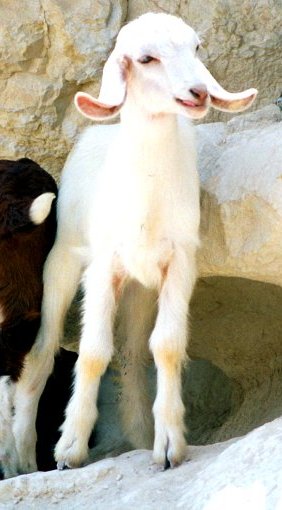
Chad GadyaorHad Gadya is a playful cumulative song in Aramaic and Hebrew. It is sung at the end of the Passover Seder, the Jewish ritual feast that marks the beginning of the Jewish holiday of Passover. The melody may have its roots in Medieval German folk music. It first appeared in a Haggadah printed in Prague in 1590, which makes it the most recent inclusion in the traditional Passover seder liturgy.

Ephraim Deinard (1846–1930) was a Hebrew bookman. He was a bookseller, bibliographer, publicist, polemicist, historian, memoirist, author, editor, and publisher. He produced some 70 volumes whose subjects range from Jewish history and antiquities, to treatises against Hasidism, Christianity, and Communism, parodies, medieval and modern Hebrew literature, Jewish religion, and especially booklore.
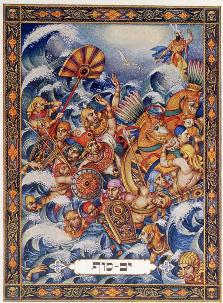
The Szyk Haggadah is a Passover Haggadah that was illustrated by the Polish-Jewish artist Arthur Szyk in Poland between 1934 and 1936. Szyk's visual commentary on the ancient story of Passover uses the vocabulary and format of an illuminated manuscript; each of his 48 full-page watercolor and gouache illuminations contains the traditional text of the Haggadah, which is clarified and interpreted by the images and symbols on the same page.
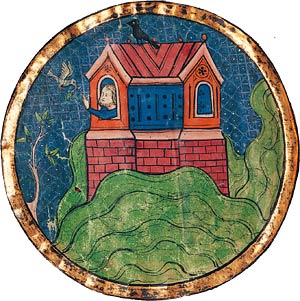
The North French Hebrew Miscellany or "French Miscellany" or "London Miscellany" is an important Hebrew illuminated manuscript from 13th-century France, created c. 1278-98. A miscellany is a manuscript containing texts of different types and by different authors, and this volume contains a wide range of Hebrew language texts, mostly religious but many secular. The manuscript is exceptional among medieval Hebrew manuscripts both for its size and the diversity of the texts and the quality and lavishness of its illuminations, which as was often the case were added by Christian specialists.
Marc Michael Epstein is Professor of Religion and Visual Culture on the Mackie M. Paschall (1899) & Norman Davis Chair at Vassar College.
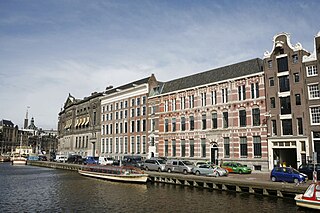
The Bibliotheca Rosenthaliana is the Jewish cultural and historical collection of the University of Amsterdam Special Collections. The foundation of the collection is the personal library of Leeser Rosenthal, whose heirs presented the collection as a gift to the city of Amsterdam in 1880. In 1877 the city library had become the University Library, so the Bibliotheca Rosenthaliana was essentially given to the University. The Bibliotheca Rosenthaliana has since expanded to become the largest collection of its kind in Continental Europe, featuring manuscripts, early printed books, broadsides, ephemera, archives, prints, drawings, newspapers, magazines, journals, and reference books.

The Birds' Head Haggadah is the oldest surviving illuminated Ashkenazi Passover Haggadah. The manuscript, produced in the Upper Rhine region of Southern Germany in the early 14th century, contains the full Hebrew text of the Haggadah, a ritual text recounting the story of Passover – the liberation of the Israelites from slavery in ancient Egypt – which is recited by participants at a Passover Seder. The text is executed in block calligraphy and accompanied by colorful illustrations of Jews performing the Seder practices and reenacting Jewish historical events. The Birds' Head Haggadah is so called because all Jewish men, women, and children depicted in the manuscript have human bodies with the faces and beaks of birds. Non-Jewish and non-human faces are blank or blurred. Numerous theories have been advanced to explain the unusual iconography, usually tied to Jewish aniconism. The Haggadah is in the possession of the Israel Museum in Jerusalem, where it is on permanent exhibition.

Irvin Ungar is an American former pulpit rabbi and antiquarian bookseller, considered the foremost expert on the artist Arthur Szyk. Ungar is credited as “the man behind the Szyk renaissance” who pulled Szyk “out of obscurity” through scholarship, exhibitions, and publications spanning nearly three decades.
Joel ben Simeon, also known as Feibush Ashkenazi was a 15th-century Jewish scribe and illuminator who worked in Germany and Northern Italy. He is best known for the manuscript today known as the Ashkenazi Haggadah.

The Golden Haggadah is an illuminated Hebrew manuscript originating around c. 1320–1330 in Catalonia. It is an example of an Illustrated Haggadah, a religious text for Jewish Passover. It contains many lavish illustrations in the High Gothic style with Italianate influence, and is perhaps one of the most distinguished illustrated manuscripts created in Spain. The Golden Haggadah is now in the British Library and can be fully viewed as part of their Digitized Manuscript Collection MS 27210.
Sefer ha-Asuppot is the name of a compilation of medieval German Jewish halakha and minhagim, the manuscript of which is privately held by David H. Feinberg of New York. The work includes a large number of teachings, minhagim, descriptions of popular costumes, halachic rulings, and collected stories from numerous authors, displaying the ordinary life of Rhineland Jews in during the twelfth and thirteenth centuries. The manuscript is endowed with vowel signs almost throughout, which makes it the only non-liturgical and non-Biblical text of its kind, and the vowels follow the Spanish pronunciation. The manuscript is the work of several scribes, containing multiple hands and multiple inks. One scribe was probably named Meir.

Franzisca Baruch was a German–Israeli graphic designer. She is known for designing Hebrew fonts, the cover of the first Israeli passport, the emblem of Jerusalem, and the logo of the Ha'aretz newspaper.
The Rylands Haggadah is an illuminated Sephardi Passover Haggadah written and illuminated in Catalonia, Spain in the mid-14th century. It is generally regarded as one of the finest preserved and most ornate Haggadot in the world, and as an example of the "cross-fertilisation between Jewish and non-Jewish artists within the medium of manuscript illumination."

The Kennicott Bible, also known as the First Kennicott Bible, is an illuminated manuscript copy of the Hebrew Bible, copied in the city of A Coruña in 1476 by the calligrapher Moses ibn Zabarah and illuminated by Joseph ibn Hayyim. This manuscript is considered by some, such as the historian Carlos Barros Guimeráns, to be the most important religious manuscript of medieval Galicia. It is also regarded as one of the most exquisite illuminated manuscripts in Hebrew in an article published by the Library of the University of Santiago de Compostela, and the most lavishly illuminated Sephardic manuscript of the 15th century by Katrin Kogman-Appel.
















